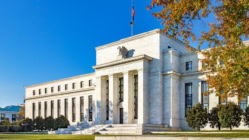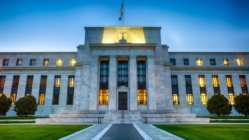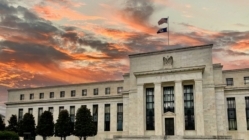If you google “wrongness,” you’ll see a picture of me screaming “Rates will fall by March of ’23!”
I am wrong a lot actually and am not afraid to admit it because it makes for great learning and blog fodder.
For example, I was wrong about when rates will fall, and I was wrong when I said that the Fed would not raise rates again after its June pause (because it usually does not raise rates again after a pause).
Before I lose too many readers, I might add that I am correct occasionally too 😊. And, when I am wrong, it is usually more about timing than being outright wrong.
As most readers know too, I simply follow a large group of macro analysts who share a large variety of perspectives – and then I share the consensus conclusions that most seem to agree on.
I follow analysts, podcasters, and money managers like Alf Peccatiello, Stephanie Pomboy, Darius Dale, Erik Townsend, Adam Taggart, Jeff Snider, Brent Johnson, Barry Habib, George Gammon, Hugh Hendry, Kyle Bass, and many others.
And most of those analysts thought the economy would soften and/or that inflation would fall, causing rates to fall, by spring of 2023.
But, that did not happen and rates continue to climb to record levels – so what happened?
Cash, Income, Stimulus, Savings and Liquidity Happened!
Far more cash continued to hit the economy throughout 2023 than any of those analysts anticipated. Here are a few of the factors that kept our economy much hotter than expected – which in turn kept rates higher than expected.
- Wage Growth: Employees were able to take advantage of a tight labor market to demand higher wages, which in turn fostered more consumer spending.
- Student Loan Forbearances: Analysts did not realize how much extra cash this put in consumer’s pockets and how much of it consumers would spend (all of it, it turns out).
- Employee Retention Credits (ERC): These are massive government handouts put in place during COVID to incentivize firms to keep employees. The ERC program turned into a spending (and often fraudulent) boondoggle that continued to pump billions into the economy every month until the IRS put a stop to it recently. This too turned out to be far more unexpected stimulus than any analyst anticipated.
- Government Spending: Our massive deficit spending is also stimulating the economy in ways that are offsetting the Fed’s efforts to slow things down. Mr. Biden signed trillions of spending into law in the form of the American Rescue Plan Act of 2021: $1.9 trillion; the Infrastructure Investment and Jobs Act: $1.2 trillion; the Inflation Reduction Act of 2022: $739 billion; and the CHIPS and Science Act: $52 billion.
- Bank Term Funding Program: This is a massive program that lets banks borrow money from the Fed that was put in place in March of 2023 to save failing banks, and but for this program, many banks likely would have failed – and rates would be lower as a result. In any case, this program too pumped far more liquidity into the economy than any analyst anticipated.
- Savings: Overall savings levels hit record levels during COVID, providing a huge spending cushion that lasted well into 2023.
- T-Bill & Money Market Income: Millions of savers and investors have seen returns from Treasury Bills, Money Market funds and even savings accounts in the 5% range this year, creating another major source of unexpected income.
- Lag Effect Delayed: When the Fed raises rates, it invariably slows the economy down (even if government spending is offsetting the impact of higher rates). But, it takes a while for those higher rates to be fully felt through refinancing or financing at those higher rates. So far, most homeowners and businesses have been able to cling to yesterday’s lower rates, but it can’t last. Housing sales and refinances have been slowed to a halt, and commercial ventures with variable-rate debt are now forced to refinance into much higher rates.
Will all this continue? No.
Wages are flatlining, and previous wage increases have been eaten up by inflation. Student loan forbearances and ERCs are done. Savings are totally depleted. And we are now finally feeling the lag effect. Even government spending will wane, as gridlock in Washington and deficit concerns will likely keep new bills from passing.
Wow, stimulus clearly works! Can we just stimulate forever? No.
Reliance on stimulus alone fosters asset bubbles and inflation – every time. Please ask China and Japan, one of which is collapsing now because of too much reliance on government stimulus (The Chinese Collapse: A (MASSIVE) Housing Overbuild) and the other which collapsed in the 1990s and has yet to recover.
Anyway, what happened in 2023 are reminders of a few things: (1) There are no certainties when it comes to economics; there are only probabilities; (2) nothing moves in a straight line; (3) it is extremely difficult to predict anything in these unprecedented times; and (4) it often takes more time for macroeconomic events to play out than most of us expect.
Am I still clinging to my recession and lower rates predictions? Hell yeah!
I make my case often for a coming recession, such as When Will Mortgage Rates Drop? and When Will The Recession Come? And, there is no reason to change my views. In fact, the delaying of the recession via stimulus only makes me think it will be that much worse – given that the delays foster even more malinvestment and dependency on government spending.
Why is everyone so convinced that rates will stay high through 2024?
Because the Fed is telling everyone they will, but as Jeff Snider and David Rosenberg remind us often – the Fed is constantly wrong, and it amazes both of them that everyone believes the Fed narrative so often in light of that fact. The other fact is recency bias – the Fed has kept rates high this long and the economy seems to be strong still, so many observers believe it will continue. We saw all this play out very similarly in 2007 and 2008.
Need more evidence?
Check out this short video WTF? New Report Says Fed Will Drop Rates to 0% in 2024! TLDW: The Fed has never fostered a soft landing in history! History shows that the Fed always drops rates much more and far faster than they ever anticipate. The narrator uses a WSJ article and several charts to drive home his point.
Here’s something really scary: M2 Money Supply at Depression-Era levels.
Check out this chart: M2 Money Supply Vs. Inflation. M2 money supply (cash, checking, savings) is falling at a pace not seen since just prior to the Great Depression in the 1930s. The video I link to above about the “Chinese Collapse” is also pretty scary, as it too will impact the entire world.
Why This Matters So Much
It matters so much because the fear of “higher for longer” (when it comes to rates) keeps potential buyers on the sidelines, and it fosters poor economic and investment decisions. A recession will come, and rates will fall, and I suspect a lot of investors will wish they’d listened to Stephanie Pomboy, Jeff Snider, Hugh Hendry, Alf Peccatiello and many other analysts.
Sign up to receive our blog daily
























